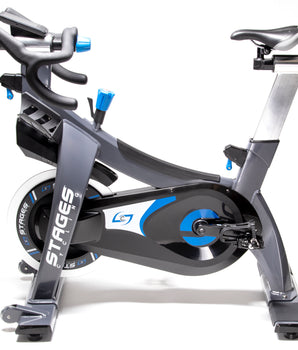1.5% - this tiny number makes a massive difference in cycling performance. In the world of power-based training, precision isn't just a feature – it's the foundation of every meaningful performance gain. When fractions of a watt can determine training effectiveness, accuracy becomes everything.
Stages Power Meters: The Science of Precise Performance
What exactly does ±1.5% accuracy mean for your training? Imagine targeting 250 watts during a threshold interval – you'll know your actual output is between 246.25 and 253.75 watts. This level of precision transforms vague training concepts into exact, measurable progress. Active temperature compensation maintains this accuracy regardless of environmental conditions.
Raw numbers tell the real story: A typical 60-minute class generates around 3,600 data points about each rider's performance. Multiply that by 30 bikes, five classes daily, and you're looking at 540,000 precise measurements every day. That's not just data – it's the blueprint for performance excellence.
Beyond Numbers: Translating Power Into Performance
Professional training lives in the watts. Dual-channel technology (ANT+ and Bluetooth) ensures your power data flows seamlessly into any training system. The result? No missed intervals, no data gaps, just continuous performance tracking that tells the complete story of every training session.
Simple yet crucial: a quick glance at the LED indicator confirms optimal operation. Battery life measured in months, not hours, means consistent performance through thousands of training sessions. Regular firmware updates ensure your measurement accuracy keeps getting better – because in power training, every watt counts.
Data-Driven Training Evolution
Numbers change everything. Instead of subjective "how it feels," you get objective "here's what happened." Instructors can now say: "Hold 85% of your FTP for 3 minutes" rather than "go hard." This precision transforms generic workouts into personalized training sessions backed by exact measurements.
Real power data enables real progress tracking: Week 1 - 195W average. Week 6 - 215W average. Week 12 - 232W average. These aren't just numbers; they're proof of progress, motivation for participants, and validation of your training methods. In power-based training, guesswork becomes obsolete.
The Power Measurement Advantage
Consider the math: A 1% improvement weekly compounds to over 67% annually. With precise power measurement, these marginal gains become trackable, targetable achievements. Every session generates performance insights that guide the next training decision.
Looking at the hard data: Facilities using power-based training report 23% better member retention. Why? Because people stick with programs that show them exactly how they're improving. When every watt is measured, every improvement becomes visible – and visible progress keeps people coming back.
Frequently Asked Questions About Stages Power Meters
- Are Stages Power Meters accurate?
- Yes, Stages Power Meters are highly accurate, offering a ±1.5% precision rate. This ensures reliable and consistent data, whether you're performing threshold intervals or tracking progress over time. The active temperature compensation feature further ensures accuracy across varying environmental conditions.
- What are the benefits of using Stages Power Meters in cycling?
- Stages Power Meters provide precise performance data that helps cyclists and instructors optimize training. Benefits include better progress tracking, personalized workout plans, improved rider engagement, and higher member retention in studios. For studio owners, the data-driven approach enhances class quality and boosts reputation.
- Do Stages Power Meters work on both legs?
- Stages Power Meters measure power output from one leg (typically the left) and use it to calculate total power. This approach is widely regarded as accurate and reliable for most cycling applications, ensuring consistent performance tracking without the added complexity or cost of dual-leg systems.









